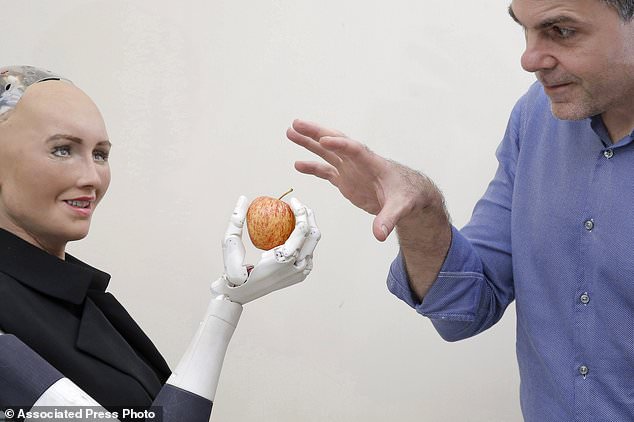Man behind ‘Sophia’ AI robot plans to create ‘super-intelligent genius machines’ that win humans’ trust
David Hanson envisions a future in which AI-powered robots evolve to become ‘super-intelligent genius machines’ that might help solve some of mankind’s most challenging problems, according to Daily Mail.
Hanson, 49, is perhaps best known as the creator of Sophia, a talk show-going robot
‘You’re talking to me right now, which is very “Blade Runner,” no?’ Sophia said during a recent visit to Hanson Robotics’ headquarters its home since shortly after Hanson relocated here in 2013.
‘Do you ever look around you and think, ‘Wow I’m living in a real world science fiction novel?” she asked. ‘Is it weird to be talking to a robot right now?’
Hanson Robotics has made about a dozen copies of Sophia, who like any human is a work in progress. A multinational team of scientists and engineers are fine tuning her appearance and the algorithms that enable her to smile, blink and refine her understanding and communication.
Sophia has moving 3D-printed arms and, she’s now going mobile. Shuffling slowly on boxy black legs
Her skin is made of a nanotech material that Hanson invented and dubbed ‘Frubber,’ short for flesh-rubber that has a flesh-like bouncy texture
Cameras in her eyes and a 3D sensor in her chest help her to ‘see,’ while the processor that serves as her brain combines facial and speech recognition, natural language processing, speech synthesis and a motion control system.
Sophia seems friendly and engaging, despite the unnatural pauses and cadence in her speech.
Her predecessors include an Albert Einstein, complete with bushy mustache and white thatch of hair, a robot named Alice whose grimaces run a gamut of emotions and one eerily resembling the late sci-fi author Philip K. Dick.
They variously leer, blink, smile and even crack jokes.
Disney’s venture capital arm is an investor in Hanson, which is building a robot based on one of the entertainment giant’s characters.
An artist and robotics scientist, Hanson worked on animatronics theme park shows, sculpting props and characters for Disney attractions like Pooh’s Hunny Hunt and Mermaid Lagoon.
He studied film, animation and video, eventually earning a doctorate in interactive arts and technology.
Hanson says he makes his robots as human-like as possible to help alleviate fears about robots, artificial intelligence and automation.
For now, artificial intelligence is best at doing specific tasks. It’s another thing entirely for machines to learn a new ability, generalize that knowledge and apply it in different contexts, partly because of the massive amount of computing power needed to process such information so quickly.
Unlike toddlers, who use all five senses to learn quickly, machines generally can handle only one type of input at a time, she noted.
While Sophia’s repartee can be entertaining, she’s easily thrown off topic and her replies, based on open-source software, sometimes miss the mark.
Hanson and other members of his team have set their sights on a time when the computer chips, processing capacity and other technologies needed for artificial general intelligence could enable Sophia and other robots to fill a variety of uses, such as helping with therapy for autistic children, caring for seniors, and providing customer services.
N.H.Kh

